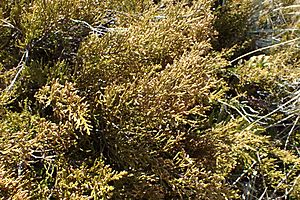Pygmy pine facts for kids
Quick facts for kids Pygmy pine |
|
|---|---|
 |
|
| Conservation status | |
| Scientific classification | |
| Genus: |
Lepidothamnus
|
| Species: |
laxifolius
|
The pygmy pine (also known as Lepidothamnus laxifolius) is a very special type of conifer. Conifers are plants that usually have cones, like pine trees. This tiny plant belongs to the Podocarpaceae family. It only grows in New Zealand, which means it is endemic there. You can find it on the North Island, South Island, and Stewart Island. It is known for being one of the smallest conifers in the world.
Where Does the Pygmy Pine Live?
The pygmy pine loves to live in high places. It is a specialist of alpine areas. You can find it in wet, spongy bog communities. It also grows in scrubland, which is an area with small trees and bushes.
Often, it grows near other unique New Zealand plants. These include the Halocarpus bidwillii and the Podocarpus nivalis. Some places where you can see the pygmy pine are Tongariro National Park and Arthur's Pass. On Stewart Island, it can be found in lower areas too.
What Does the Pygmy Pine Look Like?
The pygmy pine is a very small plant. It usually grows low to the ground. It has a "scrambling prostrate" habit, meaning its branches spread out along the ground. Some plants have been seen with fruit when they are only 8 centimeters (about 3 inches) tall!
Its branches can be up to 5 millimeters thick. They can grow up to 1 meter (about 3 feet) long. The cones of the pygmy pine are bright red and look fleshy. They grow at the very ends of the branches. Inside, the seeds are dark brown. They sit on red, fleshy scales. This plant is thought to be the smallest conifer on Earth. It is rarely bigger than a small, low-growing bush.
How Scientists Classify the Pygmy Pine
Scientists group plants into different families and genera. The pygmy pine belongs to the genus Lepidothamnus. This genus was once part of another group called Dacrydium. This was how scientists like George Bentham and Joseph Dalton Hooker classified it in 1880.
However, today's scientists have learned more. They now see Lepidothamnus as its own special group. It has three different species. One species lives in southern Chile. The other two species are found only in New Zealand.
All three species in the Lepidothamnus group have special features. Their cones look different from other similar plants. They also do not have resin ducts (tiny tubes that carry resin) in their leaves. These plants also make a special chemical called cupressuflavone. This chemical is not found in other related plants.
Young pygmy pine plants have narrow, spreading leaves. As they grow older, these leaves change. They become more pressed against the stem and have a stronger ridge. Female cones grow one by one at the ends of the branches. Each cone has 3 to 5 small, leaf-like parts called bracts. Each fertile bract holds an ovule, which is like a tiny egg that will become a seed. This ovule stays upright as it grows.


